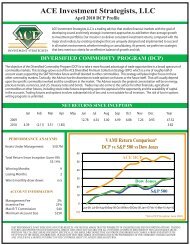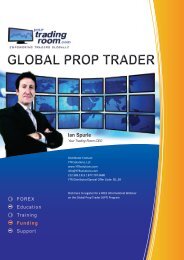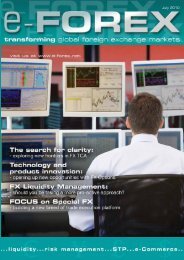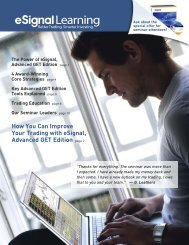You also want an ePaper? Increase the reach of your titles
YUMPU automatically turns print PDFs into web optimized ePapers that Google loves.
RETAIL e-FX PROVIDER<br />
their client base. Also, many assumptions [in this risk<br />
area] that were made in the past have obviously been<br />
proven to be incorrect.” While there have been<br />
infrequent negative events in the FX markets - usually<br />
due to the liquidity of certain currency pairs having<br />
dried up - brokers giving out credit (leverage) to their<br />
customers are keen to preserve their capital.<br />
Margin calculations<br />
In terms of the elements usually required for<br />
calculating a customers’ available FX margin in the<br />
Retail space, the core elements are the opening cash<br />
balance, customer foreign exchange positions, the<br />
leverage ratio per instrument and a particular<br />
customer’s call and close-out values.<br />
Cognotec’s O’Donnell says here: “Next generation<br />
platforms greatly assist the process of determining a<br />
customer’s available margin by tracking changes to all<br />
of this data, with the best of these systems<br />
undertaking this in real-time.”<br />
Lucas says Fortex has gone “a step further” when it<br />
<strong>com</strong>es to calculation of the margin calculations for its<br />
clients (the brokers) and added an extra layer of risk<br />
<strong>com</strong>fort. In addition to the brokers setting initial<br />
margin requirements, maintenance requirements and<br />
liquidation requirements for a trading client, by utilising<br />
Fortex technology, maximum position limits per<br />
currency pair can be set, as well as limits per orders and<br />
Sean O'Donnell<br />
“Next generation platforms greatly assist the process of<br />
determining a customer’s available margin by tracking<br />
changes to all of this data, with the best of these systems<br />
undertaking this in real-time.”<br />
106 | january 2010 e-FOREX<br />
>>><br />
number of orders. It can even be applied to customers<br />
trading more than one account. (Critically though the<br />
customer can never override the broker’s limit).<br />
He adds: “What we’ve done is to develop tools that can<br />
set limits that are more restrictive depending on the<br />
currency in question. For all those margin requirements<br />
mentioned, if a trader hits the maintenance level, we<br />
will generate real-time emails for all the relevant<br />
constituents involved.” With cash deposits made in<br />
brokerage accounts by clients usually receiving the full<br />
margin calculation (i.e. no market risk), posting<br />
securities into that same account will likely be subject<br />
to a margin ‘haircut’ (i.e. to offset the market risk).<br />
Fortex’s extra layer takes into consideration differing<br />
margin requirements on different currency pairs. For<br />
example, traders probably have a good idea of what<br />
the margin required is when trading a G8 currency<br />
(US$, Yen, etc.), and that the requirement is close to<br />
the actual risk. But when it <strong>com</strong>es to a more exotic<br />
currency, the margin requirement could well be<br />
higher to reflect the potentially greater risk.<br />
Also, if a trader trading on margin decides to say<br />
initiate an FX position, they might have to post a 2%<br />
margin. By making a $100,000 deposit, this would<br />
provide the potential to have a US$5m position (i.e.<br />
leverage of 50x). If the maintenance requirement level<br />
is set at 1% (US$50,000) and the trader’s equity falls<br />
below that figure, Fortex would again generate an<br />
email alert to all parties involved. This would include<br />
the customer (Retail trader), the broker’s risk<br />
department as well as an introducing broker - if used.<br />
Scalable and multi-dimensional<br />
Dennelly at SunGard Sierra says crucially “Whatever<br />
solution is going to be purchased, one needs to make<br />
sure that it can handle all types of [FX] products that<br />
clients are going to need to use. On top of that the<br />
margining calculation engines need to be extremely<br />
flexible and scalable.” Presently in Sierra, there are over<br />
68 different margining algorithms. They also provide<br />
an open API, so that if the customer has something<br />
that is unique and proprietary to them, they can “plug<br />
that in” and use it. The Sierra platform is “expected to<br />
be margining plus limits”, Dennelly says.<br />
FX margin calculations could also take a lesson from<br />
using a SPAN ® approach from FXBridge, a global<br />
provider of innovative software solutions to<br />
<strong>com</strong>panies operating in the high-volume/low latency<br />
FX. “Look at the entire product portfolio, assess risk,<br />
and then determine margin,” says Joe Cunningham,<br />
head of FX at FXBridge, based in Atlanta, Georgia.










